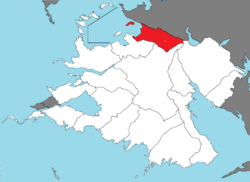Northern Isle
Northern Isle | |
|---|---|
 Northern Isle located in Zamastan | |
| Country | Zamastan |
| Capital | Lower Tariel |
| Largest city | Providence |
| Province | July 28, 1832 |
| Government | |
| • Governor | Christopher Barron (BCP) |
| Population | |
| • Total | 28,312,000 |
Northern Isle, also known as The Northern Isle is an Province of Zamastan. Despite what the name suggests, the Northern Isle is not an island, simply a large geographical and topographical anomaly carved by wide rivers in northwest Zamastan. It is bordered to the north by Gladysynthia and has been the site of many conflicts in the 20th and 21st century between Zamastan and Gladysynthia, notably the First Danaska War, Second Danaska War, and the Third Danaska War. The majority of the province's population live on the coast of Horseshoe Bay in metropolitan areas like Providence and Lower Tariel, while the rest of the province consists of deep temperate rainforests in the west; mountain ranges in the west, central, northeast, and far southeast; and a semi-arid basin region in the east, central, and south, given over to intensive agriculture.
The province's natural resources have played a major role in its economic performance, particularly with the oil extraction from Picotheca oil sands which lies beneath the north-central part of the province. Northern Isle is a leading lumber producer; its rugged surface is rich in stands of ess fir, hemlock, ponderosa pine, white pine, spruce, larch, and cedar. The state is the largest producer of apples, hops, pears, blueberries, spearmint oil, and sweet cherries in Zamastan, and ranks high in the production of apricots, asparagus, dry edible peas, grapes, lentils, peppermint oil, and potatoes. Livestock, livestock products, and commercial fishing—particularly of salmon, halibut, and bottomfish—are also significant contributors to the province's economy.
Manufacturing industries in Northern Isle include aircraft, missiles, shipbuilding, and other transportation equipment, food processing, metals and metal products, chemicals, and machinery. Northern Isle has more than a thousand dams, including the Grand Keeran Dam, built for a variety of purposes including irrigation, electricity generation, flood control, and water storage. It is one of the wealthiest as well as most socially liberal provinces in the country and consistently ranks among the best for life expectancy and low unemployment.
Etymology
History
Early history
The 9,300-year-old skeletal remains of Turre Man, one of the oldest and most complete human remains found in western Euronia, were discovered in Northern Isle in the 1990s. The area has been known to host megathrust earthquakes in the past, the last being the Tariel earthquake of 1700. Before the arrival of Adulans, the region had many established tribes of indigenous peoples, notable for their totem poles and their ornately carved canoes and masks. Prominent among their industries were salmon fishing and, notably among the Estaah, whale hunting. The peoples of the Interior had a different subsistence-based culture based on hunting, food-gathering and some forms of agriculture, as well as a dependency on salmon from the Tariel River and its tributaries. A smallpox epidemic of the 1770s devastated the native population.
Settlement
Early provincial years
Modern era
Geography
Climate
Biodiversity
Forests cover about half the province's land area, mostly west of the northern Zian Mountains. Approximately two-thirds of Northern Isle's forested area is publicly owned, including 64 percent of federal land. Common trees and plants in the region are camassia, ess fir, hemlock, penstemon, ponderosa pine, western red cedar, and many species of ferns. The province's various areas of wilderness offer sanctuary, with substantially large populations of shorebirds and marine mammals. The waters off the coast are heavily inhabited with killer, gray, and humpback whales.
In Eastern Northern Isle, the flora is vastly different. Tumbleweeds and sagebrush dominate the landscape throughout large parts of the countryside. Beleroskovian olives and other trees are common alongside riverbanks; however, apart from the riversides, large swaths of Eastern NI have no naturally existing trees at all (though many trees have been planted and are irrigated by people, of course). A wider variety of flora can be found in both the Tariel Mountains and the eastern sides of the Zians.
Mammals native to the state include the bat, black bear, bobcat, cougar, coyote, deer, elk, gray wolf, hare, moose, mountain beaver, muskrat, opossum, pocket gopher, rabbit, raccoon, river otter, skunk, and tree squirrel. Because of the wide range of geography, the Northern Isle is home to several different ecoregions, which allow for a varied range of bird species. This range includes raptors, shorebirds, woodland birds, grassland birds, ducks, and others. There have also been a large number of species introduced to the province, dating back to the late 18th century, including horses and burros. The channel catfish, lamprey, and sturgeon are among the 400 known freshwater fishes. Along with the Tariel frog, there are several forms of snakes that define the most prominent reptiles and amphibians. Coastal bays and islands are often inhabited by plentiful amounts of shellfish and whales. There are five species of salmon that ascend the Western provincial area, from streams to spawn.
